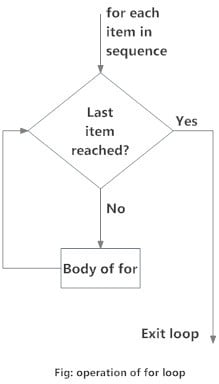In this post, you will learn for loop in the python programming language in detail.
Here you will learn what is for loop in python?, why we use for loop in python, what is syntax, definition of for loop in python and all about for loop in python.
What is for loop in Python?
Basically, for loop in any programming language is used to iterate data(array, number list, etc).
In a python programming language, for loop use list, tuple, dictionary, string, to print in sequence. Or used to iterate over other iterated objects.
Syntax of for Loop
for val in sequence: block of code
The val parameter passed in the syntax of the for loop can be string, list, truple, dictionary, etc.
Flowchart of Python for Loop

Example: python print numbers 1 to 5
# List of numbers numbers = [1, 2, 3, 4, 5] # iterate over the list for val in numbers: print(val)
Output:
1 2 3 4 5
Example: Looping Through a String
for x in "python": print(x)
Output:
p y t h o n
Example: Looping Through a Dictionary
# dictionary
d = {'foo': 1, 'bar': 2, 'baz': 3}
# iterate over the list
for val in d:
print(val)
Output:
foo bar baz
The range() function
In Python the range function is used to iterate the loop within a range.
in the range function range start from 0 by default, and increments by 1 (by default), and ends at a specified number to given in range.
and you can also pass range inside the range function and increment the with range according to your requirement
Here,
- range(n): generates a set of whole numbers starting from 0 to (n-1).
- range(start, stop): generates a set of whole numbers starting from start to stop-1.
- range(start, stop, increment): The default increment is 1 which is why when we didn’t
Example: python number in range
for x in range(5): print(x)
Output
1 2 3 4 5
Example: range function and for loop with start parameter
for x in range(2, 5): print(x)
Output
2 3 4
Example: how to create a range of numbers in python
for x in range(1, 20, 2): print(x)
Output
1 3 5 7 9 11 13 15 17 19
Example: python program to find the sum of numbers using for loop
# Program to print the sum of first 5 natural numbers
# variable to store the sum
sum = 0
# iterating over natural numbers using range()
for val in range(1, 6):
# calculating sum
sum = sum + val
# displaying sum of first 5 natural numbers
print(sum)
Output:
15
for loop with else
python for loop with else, The ‘else’ block executes only when the loop has completed all the iterations.
for val in range(5):
print(val)
else:
print("This is completed")
Output:
0 1 2 3 4 This is completed